OVERVIEW
Identification number: 48.17
Artist: Camille Pissarro
Title: Woman Washing Her Feet in a Brook
Materials: Oil on canvas
Date of creation: 1894
Dimensions: 33.3 × 41 cm
Conservator/examiner: Alex Chipkin with contributions by Laura Mosteller
Examination completed: 2022
Distinguishing Marks
Front:
The artist’s signature and the date, “C. Pissarro. 94” can be seen on the bottom left-hand corner of the painting signed in purple paint. Contrary to the prior 1970 condition report (see Summary of Treatment History section below), the signature appears to be enmeshed in the paint layer: the letters blend into the paint below, wet-in-wet (fig. 1).
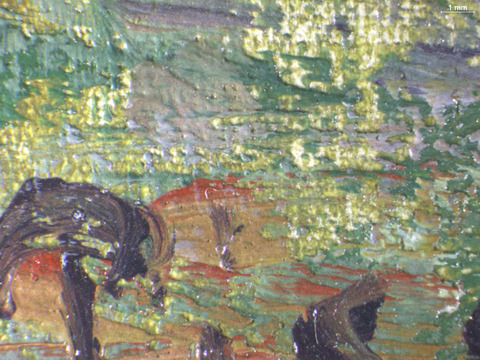
Back:
On the back, various numbers are written directly onto the stretcher bars, including an inscription that reads “Box 5” written in what appears to be pencil (zoom in to fig. 2 to see inscription). On the upper right-hand side is a paper label with the artist’s name and title of the work written in an iron-based brown ink that reads, “Jeune se lavant les pieds à la Rivière.” On the middle vertical member, beneath a number 2 written in charcoal, there is a stamp with a letter “B” surrounded by a lozenge shape (see fig, 3 for infrared photography showing the iron-based ink that appears transparent and carbon-based medium that appears opaque), above which is written “MODÈLE DÉPOSÉ.” This is the logo of stretcher manufacturer Bourgeois aîné. This stamp is seen on many other paintings by Camille Pissarro.1 This suggests that the stretcher is likely original to the painting. Pissarro would sometimes order only the canvas for stretchers he already had. In an 1887 letter to his son Lucien, Camille writes, “I beg you to ask Contet to send me a number 30 square canvas, the area of my stretcher, with enough turnover to be able to nail it on well."2 Since the painting has been lined, no stamp from the supplier of the canvas is visible.
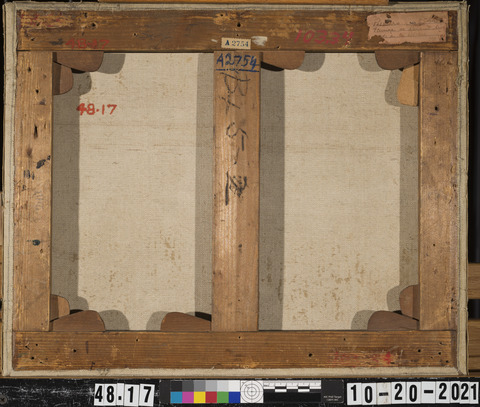
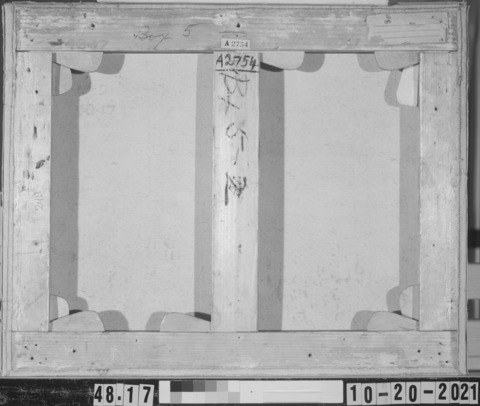
Historical Context
Woman Washing Her Feet in a Brook was painted in 1894 when Camille was living in Éragny-sur-Epte (fig. 4). He had moved to this area outside of Paris ten years earlier. Camille painted many works outdoors in this location, but this painting may have been made in the studio using preparatory sketches.3 In 1893 he had converted a barn near the house into a studio—previously, his studio had been located on the second floor of his house.4 Camille produced many works with the subject matter of bathers starting at this time. Writing from Éragny on 14 January 1894, Camille tells his son Lucien, “Since I had the press, I decided to make prints of Baigneuses.” 5 This painting is likely an étude6 for a much larger work completed in 1895, Woman Bathing Her Feet in a Brook, now at the Art Institute of Chicago (AIC) (fig. 5). As would be expected, the IMA work is simpler and more summarily painted than the AIC painting. As the above quote suggests, the AIC work was labored over for a long period of time, and one can see that in the highly built-up paint surface. Hence even though the same painting technique is used for both works, this contributes to a very different aesthetic appearance.

It was at this time that Lucien had asked his father to collaborate on a book of prints illustrating Daphnis and Chloe. Camille made the original illustrations, and Lucien cut the woodblocks to make the reproductions.7 The bathers might have been inspired by this concurrent project. In a letter to Lucien on 22 November 1894, Camille writes, “As soon as I have something, I will send it on to you. I have something which I think will be satisfactory, a Little Peasant Girl Soaking Her Feet [903], but it will have to lie around [in the studio] for the present; although it is finished, it lacks—well, something! I do think I will get it right, I feel that I will!"8 Another painting of a similar composition exists in the Metropolitan Museum of Art. In that version, the woman is nude (fig. 6).
The IMA painting is associated with several sketches. In Study of a Young Woman Bathing Her Legs Camille depicts a peasant woman in colored chalks that closely resembles the AIC painting (fig. 7). It is thought to have been drawn after the IMA work and before the AIC work. The painting is made from the sketch, which was drawn from a live model in Camille’s studio.9 There is also a sketch in black chalk depicting only hands and feet that is very similar to this sketch (fig. 8). A monoprint located in The Metropolitan Museum of Art appears to be the closest in composition to the IMA work (fig. 9). The woman has a larger head, as well as a fuller skirt and more rounded neckline. Like in the IMA work, the background is closed in and dark, with pairs of trees in the distance.
Summary of Treatment History
A 1970 report by Martin Radecki states that the painting had been lined with an aqueous adhesive prior to arrival to the Museum, and the fabric was trimmed to the edge of the painting. In describing the paint layers, he notes that some areas are thin due to over cleaning during the previous relining. Some minor damage and losses and several areas of inpainting were noted. The painting is described as having had a heavy natural resin varnish that was darkened and disfiguring, which filled in the brush strokes and neutralized tonal variations. Although this examination contradicts his findings, Radecki noted at the time that the signature floats on the surface of the coating and is not integrally involved in the paint layers. He concluded that the painting was signed either during or after the varnish was applied and suggests that it could have been signed after the painting’s completion. Radecki briefly described his treatment, noting that he removed the varnish with methanol and methyl ethyl ketone and inpainted with acrylics. He applied a final varnish of B72.10
In 1979, conservator David Miller assessed the painting and noted that it was sufficiently stable and allowed it was okay to travel for an exhibition in the spring/summer of 1980. This is when an incident was reported in which the frame was damaged after the crate was dropped. The damage occurred in an area of a previous break, and the painting was unharmed.11
In 1981, the painting was again given approval to travel in its current condition to a travelling exhibition starting in the fall of 1982 in Kyoto, then on to London, Paris, and Boston.12
In 1994, the painting was assessed for a possible loan to the Minneapolis Institute of Art and was deemed by David Miller to be in fine condition and suitable for travel, aside from the frame that needed some minor treatment. 13
Current Condition Summary
The paint layer is in excellent condition, and the canvas is in plane. Of the few age cracks visible, all are stable. There is some abrasion seen on the edges of the paint, possibly as a result of the lining and overcleaning in the past. The heat and pressure from the lining process has caused extensive flattening of the impasto throughout the entire painting (figs. 11, 12). The B72 varnish applied in the 1970 conservation treatment remains glossy. In this period, Camille’s works would not have had a saturating glossy coating. Paintings in other collections such as Woman Bathing Her Feet in a Brook and Bather in the Woods display a more appropriately matte surface. Camille “sought an effect of surface matness and roughness, attained by using semi-absorbent grounds that would ‘wick’ away medium from the paint and promote rapid drying, helping to produce porous, rough paint surfaces which scatter light.” 14 The glossy varnish and imbibed dirt that had not been removed in the prior cleaning have caused the painting’s bright colors to appear less saturated and shifted to a yellow hue. Residual natural resin varnish has pooled in the interstices of the paint causing dark pinpoints (fig. 13). Small cleaning tests have confirmed the visual effects of this degradation.
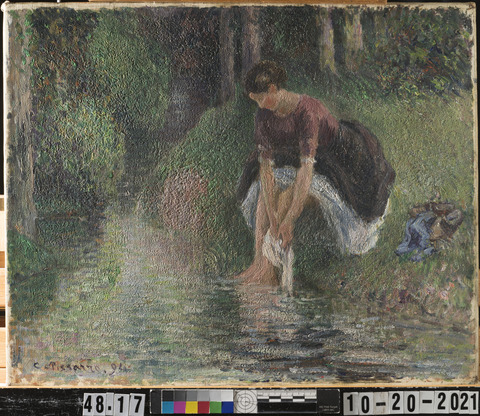
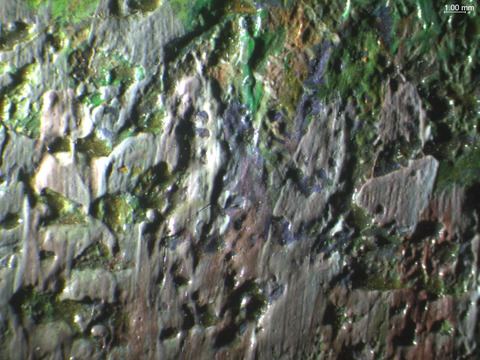

Methods of Examination and Imaging
| Examination/Imaging | Analysis (no sample required) | Analysis (sample required) |
|---|---|---|
| Unaided eye | Dendrochronology | Microchemical analysis |
| Optical microscopy | Wood identification | Fiber ID |
| Incident light | Microchemical analysis | Cross-section sampling |
| Raking light | Thread count analysis | Dispersed pigment sample |
| Reflected/specular light | X-ray fluorescence spectroscopy (XRF) | Fourier-transform infrared spectroscopy (FTIR) |
| Transmitted light | Macro X-ray fluorescence scanning (MA-XRF) | Raman microspectroscopy |
| Ultraviolet-induced visible fluorescence (UV) | ||
| Infrared reflectography (IRR) | Gas chromatography–mass spectrometry (GC-MS) | |
| Infrared transmittography (IRT) | Scanning electron microscope -energy dispersive X-ray spectroscopy (SEM-EDS) | |
| Infrared luminescence | Other: | |
| X-radiography |
Technical Examination
Description of Support
Woman Washing Her Feet in a Brook is painted on a fine, plain-weave linen canvas (untested). The canvas has thread count of 33.2 × 35.8 cm.15 The painting measures 33.3 × 41 cm, which correlates to the standard number 6 “Figure” size pre-stretched canvas (41 × 33 cm) turned horizontally.16 The tacking margins of the original canvas remain intact. However, it is unclear whether the edges of the canvas have been trimmed during a past treatment. The excess canvas at the corners that would typically be folded under has been removed. The painting appears to be double lined: the first canvas meets with the edge of the original tacking margins. The second extends across the back, the edges adhered to the stretcher bars. There is a line drawn on the edges of the lining canvas in what appears to be graphite, presumably to denote the measurement of the canvas in preparation for cutting it to the appropriate size. Both lining canvases appear to be identical and are of a heavier weight than the original.
Auxiliary Support
Original Not original Not able to discern None
Attachment to Auxiliary Support
The painting is mounted onto a five-member stretcher with mortise and tenon joints at the center member and corners (fig. 2). There are 75 evenly spaced tacks affixing the painting to the stretcher. The tacks appear to be original as evidenced by their patina, and they are placed adjacent to previous tack holes. All eight stretcher keys are present but not secured to the stretcher bars. As noted in the Distinguishing Marks section above, a stamp on the vertical cross member from stretcher manufacturer Bourgeoise aîné implies that the stretcher is original.
Condition of Support
The painting is taut and holding in plane.
Description of Ground
Materials/Binding Medium:
The presence of lead on the areas of exposed ground at the edges of the painting observed through MA-XRF scans is indicative of the use of lead white as a priming layer (fig. 14). It is likely bound in oil (untested).
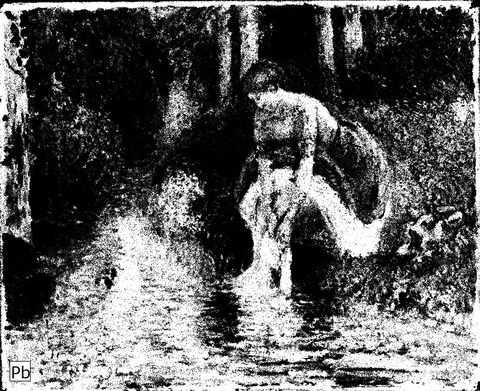
Color:
White
Application:
The painting is primed with a single ground. This layer extends to edge canvas, which indicates that it may have been commercially applied. Camille Pissarro often sourced pre-primed canvases from his suppliers.17 However, this cannot be confirmed since the canvas may have been cut down during the lining procedure.
Thickness:
The ground is applied in a thin layer.
Sizing:
Likely gelatin (untested)
Character and Appearance (Does texture of support remain detectable/prominent?):
The single application of ground has filled the interstices of the canvas weave, leaving the texture of the canvas visible. This preparation is known as à grain, and in combination with the use of stiff paint, would create a sparkling, broken texture that was preferred by many Impressionists (fig. 15).18 To create the look of glistening water, Camille utilized the textured ground and stiff paint. When brushed onto the canvas, the paint clung only to the peaks of the canvas weave, creating a broken-up appearance (fig. 16).
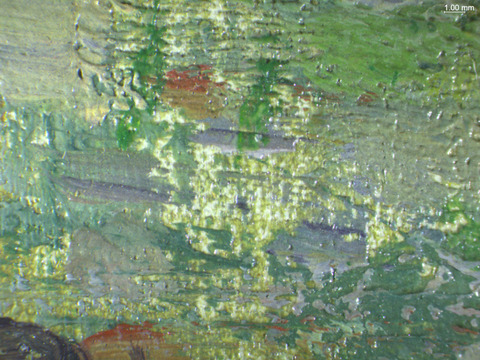
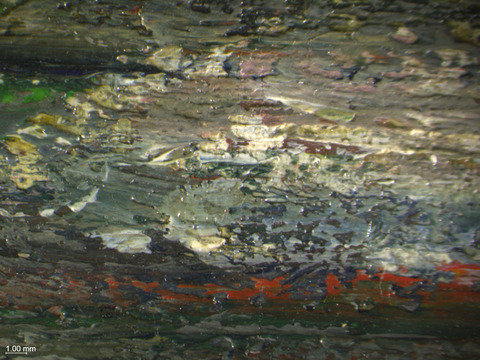
Condition of Ground
The ground layer is well bound to the support and shows no signs of cleavage below the paint layers. On the corners of the painting, there are some losses where the bare canvas is visible (fig. 17). There is a layer of surface dirt underneath residual natural resin varnish on the borders of the painting, causing the exposed ground on the edges to appear yellow-gray in hue (figs. 18, 19).
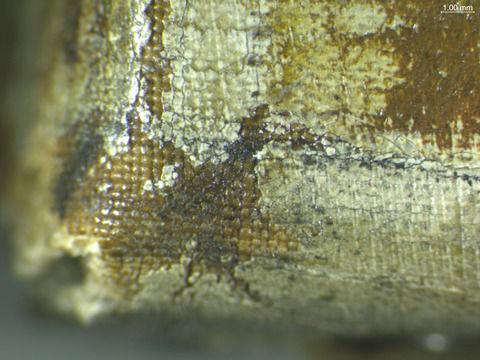

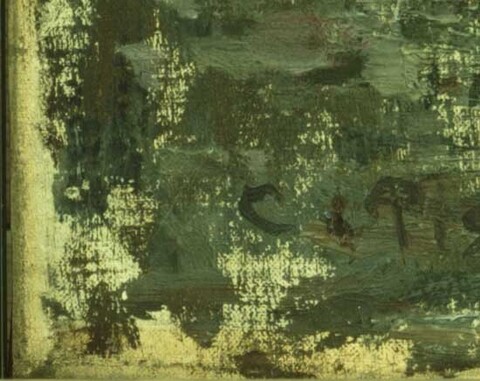
Description of Composition Planning
Methods of Analysis:
Surface observation (unaided or with magnification)
Infrared reflectography (IRR)
X-radiography
Analysis Parameters:
| X-Ray equipment | GE Inspection Technologies Type: ERESCO 200MFR 3.1, Tube S/N: MIR 201E 58-2812, EN 12543: 1.0mm, Filter: 0.8mm Be + 2mm Al |
|---|---|
| KV: | 25 |
| mA: | 3.0 |
| Exposure time (s) | 90 |
| Distance from X-ray tube: | 36 |
| IRR equipment and wavelength | Modified Nikon D610 camera with a Coastal Optics lens and X-nite 1000C filter |
Medium/Technique
There is an underdrawing present, painted in fluid blue paint. As mentioned previously in the Historical Context section, Camille began the planning stages for his paintings of bathers with various drawings and prints. Referring to these sketches, Camille painted the blue lines directly onto the ground to denote the shapes and placement of elements. He then built up the subsequent layers in oil paint, covering these lines for the most part. As he painted, Camille would sometimes make changes. In order to guide these new forms, he reiterated the blue line on top of the already laid-down paint layers. Under magnification, this blue underdrawing is visible, painted directly on the ground, partially covered by paint layers above (fig. 20). Also visible are the reiterated lines (see fig. 21, showing the blue line painted over the still-wet paint layer, blended with the skin colors of the woman’s proper right foot). This planning technique is consistent with the larger Woman Bathing Her Feet in a Brook (fig. 5). In this painting, Camille had repositioned the nose: under magnification the blue line of the underdrawing can be seen sandwiched between paint layers above and below (fig. 22). The line is also seen underneath paint layers, placed directly on the ground (fig. 23). After the underdrawing was mapped out, Camille usually laid in blocks of color, leaving a narrow space of ground between each element. In the X-radiography, we can see a dark border surrounding each element, which indicates a thinner application of paint in those areas (fig. 24). The same spaces between the elements can be observed in other paintings by Pissarro, including the AIC work (fig. 25).19 In both cases, as Camille continued to paint, he would fill in these spaces.
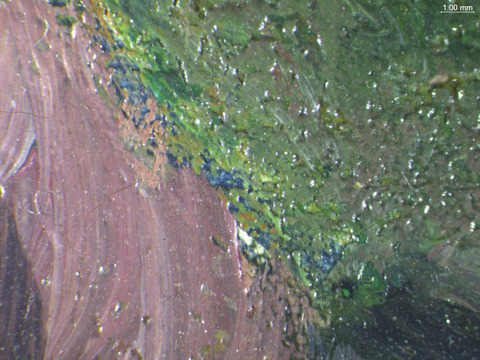
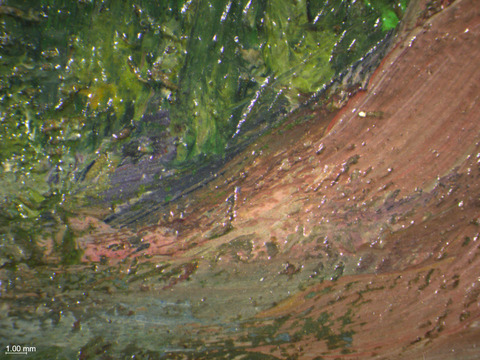
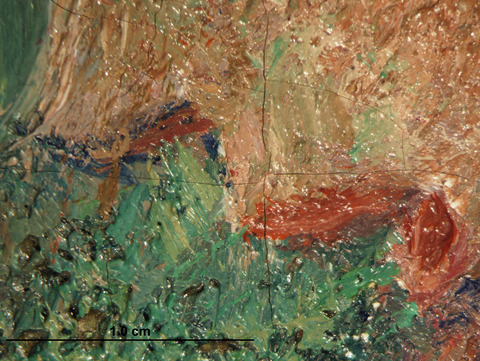

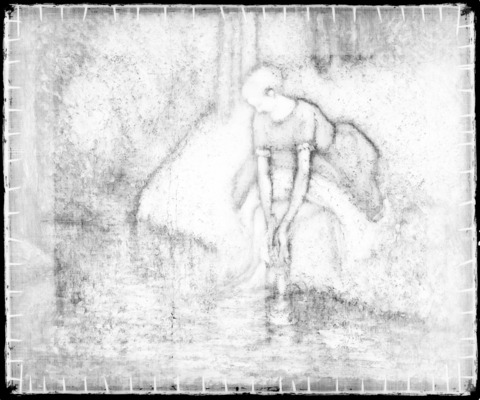
Description of Paint
Analyzed Observed
Application and Technique:
By the time this work was made, Camille had moved away from the strict Pointillist techniques he was using in the previous decade. In this painting, he employs a much freer paint application in comma-like brushstrokes (zoom in to fig. 4). For most of the painting, Camille did not wait for the paint to dry between each layer; he built up the paint wet-in-wet, mixing the colors on the surface of the canvas in many areas. This contributes to a muddied appearance in some passages. Although Camille used the same painting techniques for the AIC work, it has a different appearance because of the heavier impasto. The painting was built up in multiple campaigns of wet-in-wet layers. As suggested by the quote in the Historical Context section, he left the painting to the side when he was dissatisfied, and then came back to it after some time (presumably after the paint layer had dried) to make changes.
For the most part, Camille kept within the confines of the underdrawing he had initially laid in, leaving a space between each element. But some things he changed as he went. For example, the neck was made marginally thinner where one can see the blue underdrawing of the neck (fig. 26). As mentioned previously in the Description of Composition Planning section, the foot has been adjusted, necessitating the reiteration of the blue underdrawing (see fig. 21 above). The adjustment was made while the paint layer was still wet. In other areas, one can observe that he waited for the paint layer to dry before making changes, as he would do later in the AIC work. For example, the head was made slightly smaller with addition green paint used for the grass and purple for the tree trunks painted over the contour of the hair, wet-over-dry (fig. 26, 27).


Painting Tools:
Soft brushes of varying sizes
Binding Media:
Oil paint (untested)
Color Palette:
The blue paint used for the underdrawing was identified as synthetic French ultramarine with the use of in-situ Raman microspectroscopy. French ultramarine underdrawings have been found in other paintings by Camille Pissarro.20 The presence of both copper and arsenic in the foliage and grass observed through MA-XRF scans (figs 28) is indicative of the use of emerald green paint.
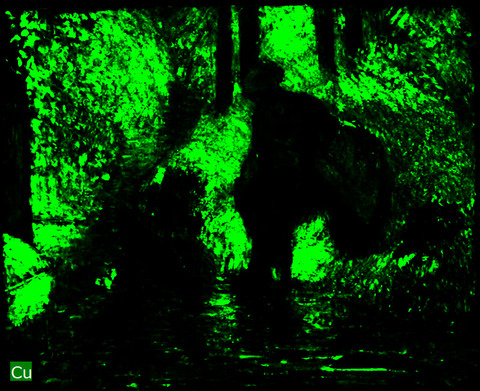

MA-XRF analysis detected chromium in the grass as well, indicating the use chrome yellow and viridian (fig. 29).
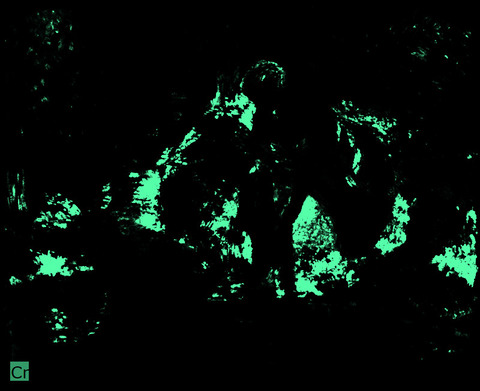
The MA-XRF map for cobalt indicates that cobalt blue was used for the water, the garment to the proper right of the figure, as well as in the grass and trees. The zinc and cobalt maps match exactly, suggesting that these passages may have been painted with a pre-mixed tube paint containing both pigments (fig. 30).
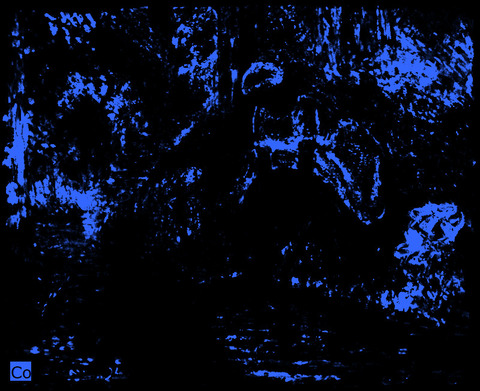

The MA-XRF scan for mercury indicates the use of paint mixtures containing vermilion for the red and orange foliage, the woman’s rosy cheeks, purple blouse, and beige clogs to her proper right (fig. 31). It was also used to deepen the shadows of her skirt.

The MA-XRF lead map indicates the use of lead white paint for the woman’s complexion, underskirt, and sleeves, as well as highlights on the water and the tree trunks (fig. 14).
Condition of Paint
The paint layer is in excellent condition. Of the few age cracks visible, all are stable.
Some abrasion is seen on the edges of the paint, likely from the lining and possibly over cleaning in the past. Because the previous treatment had flattened the peaks of the impasto, the painting is dotted with small pits.
Description of Varnish/Surface Coating
Analyzed Observed Documented
| Type of Varnish | Application |
|---|---|
| Natural resin | Spray applied |
| Synthetic resin/other | Brush applied |
| Multiple Layers observed | Undetermined |
| No coating detected |
The painting is coated with a synthetic B72 varnish, which was applied in 1970.
Condition of Varnish/Surface Coating:
There are remnants of the prior natural resin varnish on the painting in the interstices of the dabs of paint, as well as some of the high points of the brushstrokes mostly in the green passages, indicating that the painting was selectively cleaned. The natural resin is present on the upper left-hand side and on the orange leaves and the foliage below, as well as on most of the grass on the right-hand side. This can be seen in the ultraviolet-induced visible fluorescence image (fig. 32). The selective cleaning may have been undertaken because of sensitivity of the green paint to polar solvents. There is very little retouching on the painting; only one area on the proper right leg, seen in UV and more clearly in the MA-XRF scan for titanium, which indicates the retouching paint contains titanium white (fig. 33).


Description of Frame
Original/first frame
Period frame
Authenticity cannot be determined at this time/ further art historical research necessary
Reproduction frame (fabricated in the style of)
Replica frame (copy of an existing period frame)
Modern frame


Frame Dimensions:
Outside dimensions: 51.4 × 60.3 cm
Rebate dimensions: 33.5 × 41.6 cm
Sight size dimensions: 30.8 × 39.7 cm
Rail width: 10.2 cm
Distinguishing Marks:
Pale blue paper label on the back of the frame, top rail, center; printed in black ink: “WOMAN WASHING HER FEET AT THE BROOK – Pissarro/ Lent by The John Herron Art Institute, Indianapolis, Ind[ ].” Paper is skinned and torn at ends, possibly missing information (fig. 35).
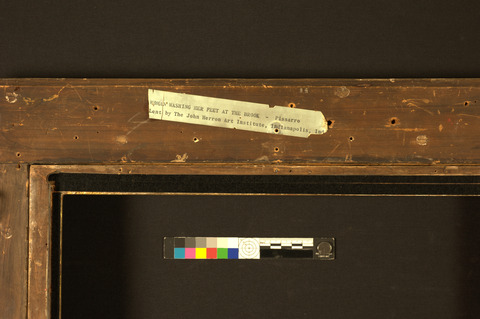
Paper labels on the back of the frame, bottom rail, lower right corner:
White paper support with printed red ink border, inscription in graphite, “5028/1.”
White paper support with printed blue ink numbers, “7573D,” missing upper-left corner tip.
Inscription in blue wax crayon, bottom rail, center: “01.” (fig. 36)

Paper label on frame back, top rail, upper-right corner: white paper support with printed blue ink numbers, “7556D.”
Paper label on frame back, right side rail, center: white paper support with printed red ink border; no visible notation. Paper support is torn horizontally through the center and is missing the bottom half portion (fig. 37).
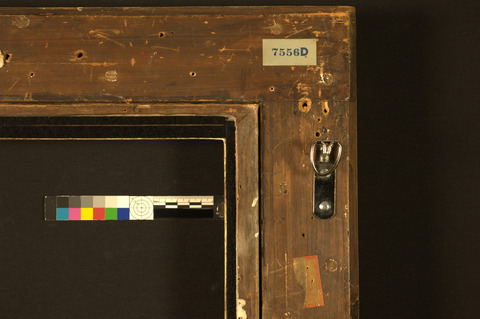
Description of Molding/Profile
The primary gilded Barbizon-style frame has a secondary slip frame at the sight edge. The slip has a flat profile with a cavetto sight edge and is water gilded with visible lay lines and a slightly rubbed finish over red ground. The top rail of the slip is chiseled along the rabbet to allow for a larger size to the vertical measurement and to accommodate the painting canvas (fig 37).
The primary frame profile has an acanthus repeat at the base of the scotia. A quarter round front edge with cross-cut acanthus borderlines a scalloped ribbon that overhangs a fluted cove. A small ogee profile is at the sight edge ornamented with acanthus and tongue repeat, followed by the slip frame.
The joinery for the primary frame is a 45-degree miter; the back sub-molding has lap joins that can be noted due to stress cracks in the gilding along the back edge of the frame (fig. 38).

The lap molding on the back of the frame is attached with regular flat-head screws that are counter-sunk along the perimeter, located approximately 2.5 cm from the outer edge and roughly 10.2 to 15.2 cm apart. The counter-sunk holes are in-filled, sanded, and toned to match the wood surface of the back. The fills are uniformly circular and approximately 0.95 cm in diameter. Some of the fill material has crumbled and the screw heads are visible with the aid of microscopy, as well as noted in the X-radiograph (fig. 39). In addition to the modern metal hardware, there are hand-made flat nails visible in the X-radiograph that were used to attach the carved frame elements together. The head of one of those nails is visible in the carved ornament, located in the left side rail at the outer edge of the top corner.
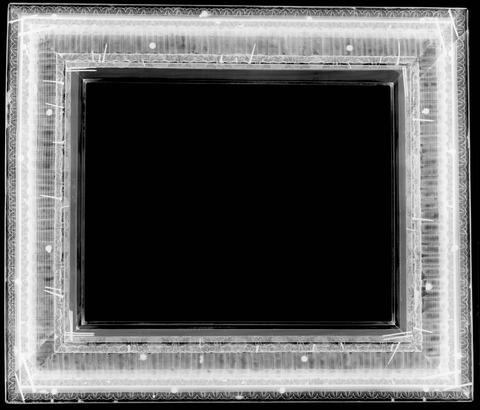
The frame surface has been oil gilded with gold leaf and an applied tone; a pale gray wash imparts an intentional dusty look most notable in the fluted cove where it dulls the brightness of the gold leaf considerably.
Condition of Frame
The frame is structurally secure. Cosmetic problems in the gilded surface are evident with cupping gold leaf and insecurity within the gesso layer. Microscopy examination in an area of damage shows distinct stratification, clearly indicating two layers of gilded gesso. The cupping of gold leaf in the interstices suggests an excess of oil size in the second finishing campaign that has prevented a successful bond between the gesso and the gold leaf; the wood carved ornament lacks clarity under the multiple finishing layers.
The sight edge of the primary frame is an ogee profile with an acanthus and tongue carved ornament. The right-side member is significantly damaged and has extensive and poorly executed previous restoration; much of the original carving is lost and fill material is applied in a haphazard way without regard to the acanthus embellishment. The fill material composition is unknown, and the repair is in-gilded with a ground metallic product, binder not tested, possibly varnish or wax cream/paste.
Notes
-
See Gloria Groom and Genevieve Westerby, eds., Pissarro Paintings and Works on Paper at the Art Institute of Chicago (The Art Institute of Chicago, 2015), https://publications.artic.edu/pissarro/reader/paintingsandpaper/section/8/8_anchor. ↩︎
-
D. Bomford et al., Art in the Making: Impressionism (London: National Gallery in association with Yale University Press, 1991), 47. ↩︎
-
See Joachim Pissarro and Claire Durand-Ruel Snollaerts, Pissarro: Critical Catalogue of Paintings Paintings (Milan: Skira; Paris: Wildenstein Institute, 2005), 3:676. The authors note that according to Camille’s letters, other works depicting peasant women at a brook were painted in the studio. See also G. Groom and G. Westerby, eds., Pissarro Paintings and Works on Paper at the Art Institute of Chicago (The Art Institute of Chicago, 2015), https://publications.artic.edu/pissarro/reader/paintingsandpaper/section/8/8_anchor. ↩︎
-
Joachim Pissarro and Claire Durand-Ruel Snollaerts, Pissarro: Critical Catalogue of Paintings (Milan: Skira; Paris: Wildenstein Institute, 2005), 3:499, 661. ↩︎
-
See John Rewald, Camille Pissarro: Letters to His Son Lucien (Boston: MFA Publications, 2002), 226. ↩︎
-
An étude is a preparatory work for a final painting. It could be used to plan the colors and composition of the larger work but also could be considered a finished painting itself. ↩︎
-
See John Rewald, Camille Pissarro: Letters to His Son Lucien (Boston: MFA Publications, 2002), 232. ↩︎
-
See John Rewald, Camille Pissarro: Letters to His Son Lucien (Boston: MFA Publications, 2002), 252. Rewald refers to Woman Bathing Her Feet in a Brook now located in the Art Institute of Chicago. Painting number 903 referred to in the transcription corresponds to reproductions in the first catalogue raisonné, Ludovic-Rodo Pissarro and Lionello Venturi, Camille Pisssarro: Son Art – Son Oeuvre (Paris: Paul Rosenberg, 1939), 2:183. ↩︎
-
See Richard Brettell and Christopher Lloyd, A Catalogue of the Drawings by Camille Pissarro in the Ashmolean Museum, Oxford (New York: Clarendon Press, 1980), no. 259, p. 186, referenced in Gloria Groom and Genevieve Westerby, eds., Pissarro Paintings and Works on Paper at the Art Institute of Chicago (The Art Institute of Chicago, 2015), https://publications.artic.edu/pissarro/reader/paintingsandpaper/section/8/8_anchor. ↩︎
-
Martin Radecki, “Indianapolis Museum of Art Conservation Laboratory Technical Record,” 19 June 1970, Conservation Department Files, Indianapolis Museum of Art at Newfields. ↩︎
-
David Miller, “Work Request Form,” 18 December 1979, Conservation Department Files, Indianapolis Museum of Art at Newfields. ↩︎
-
David Miller, “Work Request Form,” 18 November 1981, Conservation Department Files, Indianapolis Museum of Art at Newfields. ↩︎
-
David Miller, “Work Request Form,” 14 June 1994, Conservation Department Files, Indianapolis Museum of Art at Newfields. ↩︎
-
Lydia Gutierrez and Aviva Burnstock, “Technical Examination of Works by Camille and Lucien Pissarro from the Courtauld Gallery,” ArtMatters 5 (2013): 16, https://www.amjournal.org/_files/ugd/14a82d_1cd5fda55c9d4cdbb5cf6168377f1fd2.pdf. ↩︎
-
D.H. Johnson, “Thread Count Report: Woman Washing Her Feet in a Brook Camille Pissarro 1894 (PS1060/48.17) Indianapolis Museum of Art,” December 2021, p. 1. Conservation Department Files, Indianapolis Museum of Art at Newfields. ↩︎
-
See 1888 Bourgeois aîné table of ready-stretched canvases in D. Bomford et al., Art in the Making: Impressionism (London: National Gallery in association with Yale University Press, 1991), 46. ↩︎
-
See Lydia Gutierrez and Aviva Burnstock, “Technical Examination of Works by Camille and Lucien Pissarro from the Courtauld Gallery,” ArtMatters 5 (2013): 13, https://www.amjournal.org/_files/ugd/14a82d_1cd5fda55c9d4cdbb5cf6168377f1fd2.pdf. ↩︎
-
D. Bomford et al., Art in the Making: Impressionism (London: National Gallery in association with Yale University Press, 1991), 47. ↩︎
-
D. Bomford et al., Art in the Making: Impressionism (London: National Gallery in association with Yale University Press, 1991), 160–162. ↩︎
-
L. Gutierrez and A. Burnstock, “Technical Examination of Works by Camille and Lucien Pissarro from the Courtauld Gallery,” ArtMatters 5 (2013): 17, https://www.amjournal.org/_files/ugd/14a82d_1cd5fda55c9d4cdbb5cf6168377f1fd2.pdf. ↩︎
Additional Images











